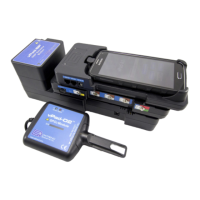vPad-A1 OPERATORS MANUAL
4.4 Temperature/Cardiac Output
4.4.1 General
Temperature and Cardiac Output simulations are combined on the same menu
since both make use of thermistor-based temperature measurements. Their
common setup interface can be accessed by touching the T/CO tab on the Main
screen (
Figure 17
). The topmost dropdown list allows users to select between the
two different simulations.
4.4.2 Parameters
4.4.2.1 Temperature
The A1 Patient Simulator generates Temperature sensor (thermistor) signals
by presenting precise resistance values to two independent channels, one for
YSI series 400 temperature probes, and the other for YSI series 700. The
interface cable used to connect the vPad-PS module to the patient monitor
will determine which of the two channels is used.
Simulated Temperatures range from 20 EC and 42 EC in steps of 0.5 EC.
Accuracy is generally ± 0.03 EC, but the module achieves a greater accuracy
of ± 0.01 EC for the following specific temperatures: 30, 32, 35, 37, 40 and
42 EC.
High-accuracy Temperatures are listed beneath the Temperature selection buttons.
4.4.2.2 Cardiac Output Testing
Cardiac Output simulations of vPad-A1 are based on the thermodilution
technique for hemodynamics monitoring. Thermodilution is an invasive
procedure that injects a known volume of chilled saline at a set temperature
into the heart. As the saline mixes with blood at body temperature, a
temperature profile is created from which the Cardiac Output can be
calculated in Liters per minute (L/min).
An optional Cardiac Output Adapter box (#8000-454) is required to
interface vPad-A1 with the cardiac catheter and injectate temperature probe
of the monitor under test. This CO Adapter is compatible with Baxter (Edwards) catheters and
equivalent models from other manufacturers such as Abbott and Viggo-SpectraMed. These
catheters have a blood temperature connection as shown in
Figure 50
.
Figure 48
Figure 49
Figure 50
Manual Operation/Chapter 4 # Page 43

